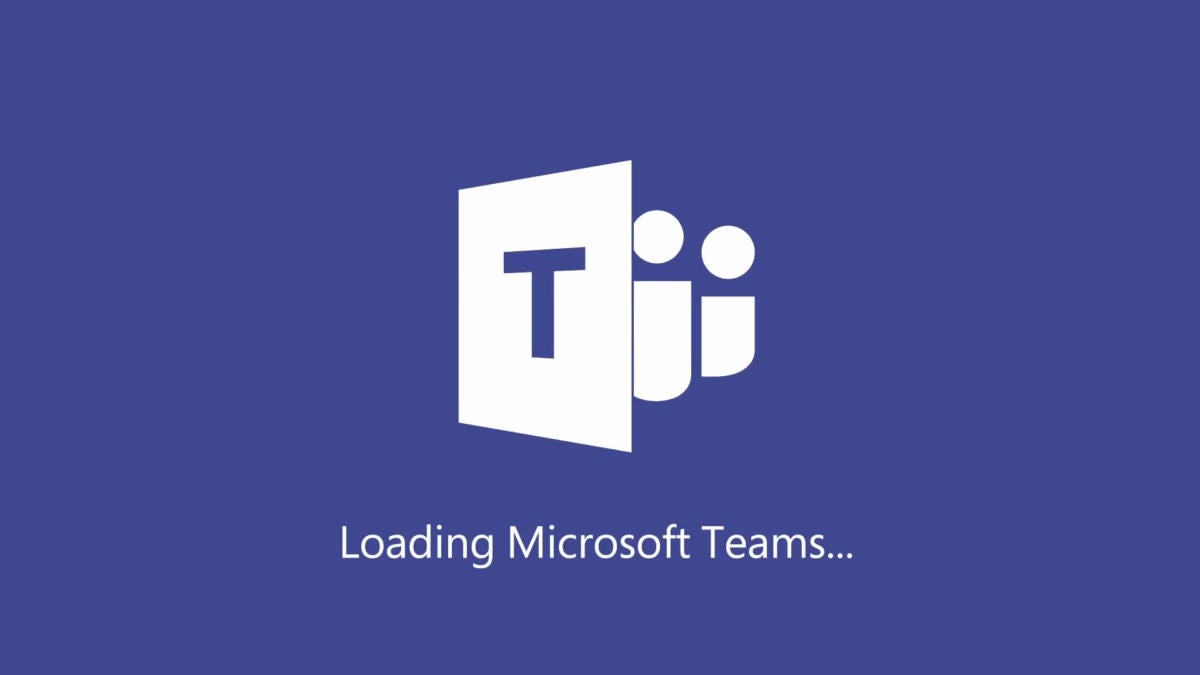
Microsoft launched Teams last year as its own take on the booming market for group messaging apps led by Slack and now also fought over by Google, Facebook and Cisco, to name but a few.
As with all team chat tools, the core aim of Microsoft Teams is to connect staff and enhance productivity, providing an alternative to – or even replacing – email. Microsoft describes it as a “digital translation of an open office space.” That’s how a company spokesperson described the software.
While Microsoft is effectively playing catch up with Slack, it has quickly positioned Teams as the central hub for communications and collaboration within Office 365 – evidenced by the decision to replace Skype for Business with Teams.
The company’s long-standing presence in the workplace with its Office suite (and of course, Windows) gives it a solid foundation to grow in the collaboration marketplace.
“Clearly, Microsoft is putting some weight behind Teams in terms of product development and product marketing,” said Richard Edwards, distinguished research analyst and research director at Freeform Dynamics. “It certainly has shifted from being a sort of tactical experiment project a few years ago to becoming strategic for Microsoft.”
- How to use Microsoft Teams
- Microsoft Teams pricing
- Microsoft Teams vs. Slack (and others)
- Microsoft Teams deployment challenges
- Microsoft Teams replaces Skype for Business: What it means to you
How to use Microsoft Teams
At its most basic level, Teams is a messaging tool that enables text communications between users, whether they are in the same office or work remotely.
It supports group chat rooms with threaded conversations, as well as private messages between individuals. When necessary, users can jump from instant messaging to a video call at the push of a button.
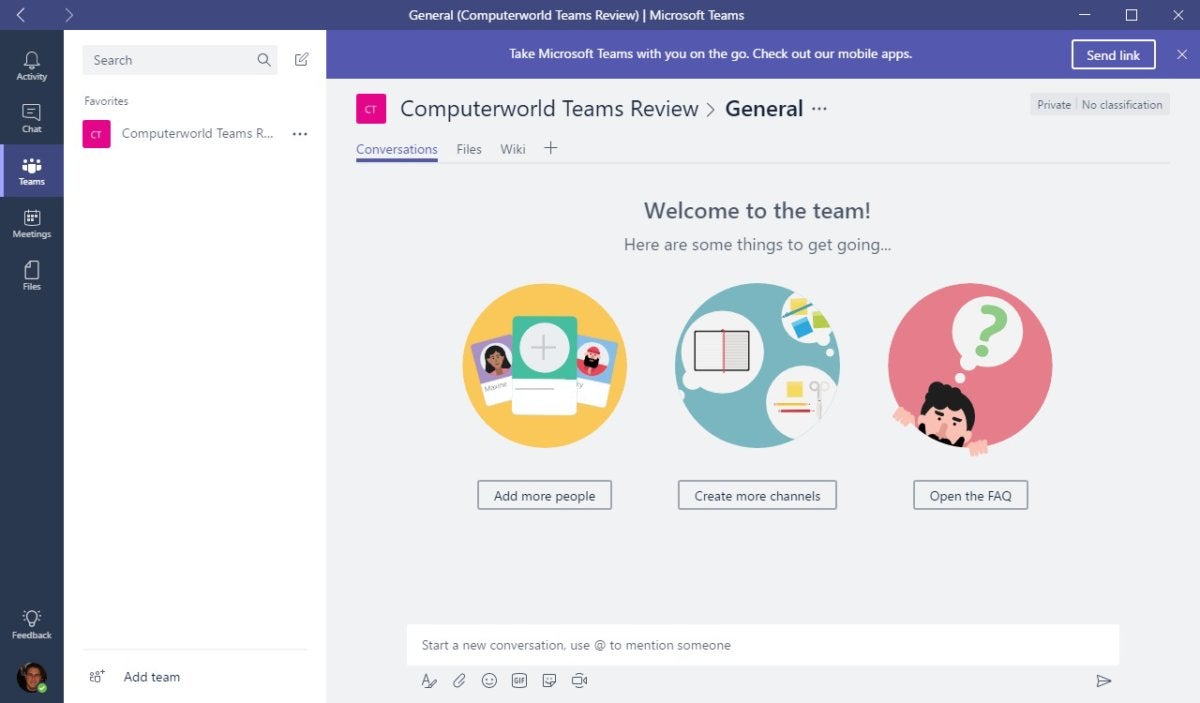 Jonathan Hassell / IDG
Jonathan Hassell / IDG“It is a simple conversation method that most people will be able to understand,” said Gartner research director Larry Cannell.
However, he notes that Teams is more than a communications tool: it also combines strong content collaboration features, thanks to integration with Microsoft’s software portfolio. OneDrive documents can be accessed and edited without leaving the app, for example.
“That’s one of the strengths it has over Slack,” said Cannell. “It is just not about group chat, it also about group file-sharing and content collaboration.”
Microsoft launched its app directory in January and Teams integrates with numerous third party bots and applications including project management tools like Trello, Smartsheet and Wrike.
[ Related: What is Trello? A guide to Atlassian’s collaboration and work management tool]
Teams is one of several collaboration applications in Microsoft’s portfolio, with Yammer, Outlook and Sharepoint all providing some overlapping functionality. Though that can lead to confusion about which tool is best for which task, Hunter Willis, solutions engineer at Microsoft partner AvePoint, said that Yammer and Teams have differing purposes and can “coexist” as separate collaboration platforms at the same company.
 Jonathan Hassell / IDG
Jonathan Hassell / IDG“Organizations should use Yammer for company-wide announcements and engagement, such as HR professional development initiatives,” he said.
Microsoft Teams, on the other hand, works best with smaller, close-knit groups. “You are much less likely to lose yourself in a large volume of Teams posts, which also means you will get responses from employees faster through Teams,” he said.
The cloud-hosted software is available via browser, desktop app and mobile app, and will be tightly integrated into Microsoft’s upcoming Surface Hub 2 digital whiteboards.
Microsoft Teams pricing
Teams is available to Office 365 account holders on these license plans: Business Essentials, Business Premium, Enterprise E1, E3 or E5.
The cheapest option – Business Essentials – costs $5 per user per month on an annual basis, while the most expensive – E5 – costs $35 per person each month. Of course, all subscriptions include access to a range of additional Microsoft applications, as well as security and compliance features within Office 365.
Furthermore, Teams is also available as part of the A1, A3 and A5 licensesfor students, though it is not currently included in government customer packages.
In contrast, Slack offers a freemium payment plan for access to its software, with three pricing tiers for individual and business users, as well as a product – Enterprise Grid – aimed at large deployments.
That kind of approach is taken by other standalone app providers, too, including Atlassian Stride, Facebook’s Workplace and Cisco Webex Teams. Though there has been speculation about a free version of Teams, Microsoft has so far remained tight-lipped about any such plans.
The closest comparison on price is with Google Hangouts Chat, which includes its Hangouts Chat messaging app in G Suite subscriptions; prices range from $5 to $25 per user per month, and provide access to a wide range of applications.
Microsoft Teams vs. Slack (and others)
At first glance, the main rival for Teams is Slack; not surprisingly, Microsoft’s application was developed as a response to it, said Edwards. Microsoft reportedly considered acquiring Slack two years ago, before founder Bill Gates and CEO Satya Nadella vetoed plans in favor of Microsoft building its own application.
As of March, some 200,000 organizations are using Teams – up from 125,000 in September – though Microsoft doesn’t break out monthly user figures. In comparison, Slack has three million paid users and 70,000 paid teams, with a total user base of eight million, thanks to its free tier.
Side-by-side comparisons between competing collaboration apps can be problematic, because they tackle similar tasks in different ways. But each tool offers some key strengths. For Teams, it is the availability within certain Office 365 subscriptions for no extra fee. This makes a compelling argument for existing Office 365 users – of which there are 135 million – using Teams rather than shelling out money for a separate tool.
“The question organizations are likely to be asking themselves is…, ‘Is the alternative that much better than Microsoft Teams that we want to go pay a separate subscription to go and use it?’” said Edwards.
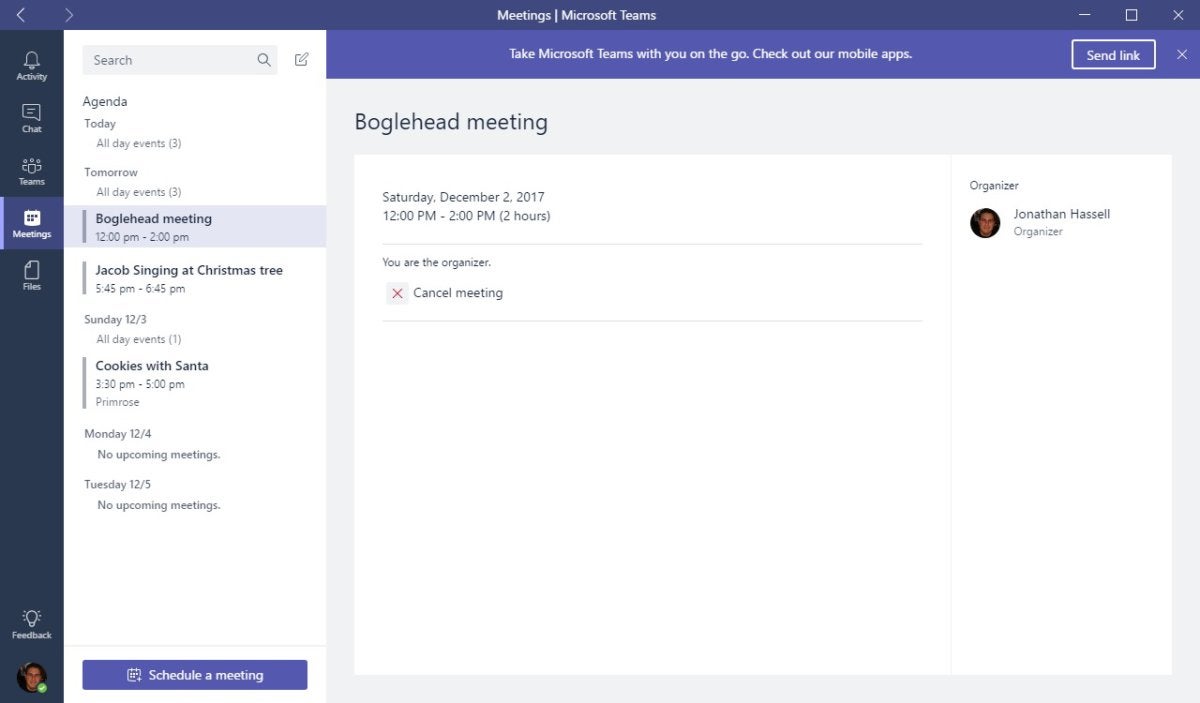 Jonathan Hassell / IDG
Jonathan Hassell / IDGAs group collaboration tools gain wider adoption, Microsoft can also leverage its enterprise roots to encourage large-scale Teams rollouts. “Teams is a latecomer to chat-based collaboration software, but has the advantage of Microsoft’s years of experience in tailoring software for the corporate environment,” said Willis.
Nevertheless, Slack has advantages that will better suit some organizations and users. Slack gained traction with early adopters of collaboration tools, particularly among developers. Matching this ”viral” adoption is a challenge for Microsoft, and there is no ”free” version of the software – for now at least.
In addition, Slack’s openness and capability to integrate with a wide array of applications is a major plus. “Slack has more ready-to-go integrations with external systems,” said Cannell. “For example, Slack has integration with Salesforce that Teams doesn’t have, [or] even with its own internal CRM systems.”
Of course, Slack is far from the only team chat tool available. There are many other apps that offer similar capabilities to Teams on a variety of levels. For example, Google’s Hangouts Chat and Hangouts Meet also offer a ”suite”-based approach, and are available alongside Google’s G Suite productivity tools such as Gmail, Docs and Sheets.
Cisco’s Webex Teams – formerly Spark – mirrors Microsoft’s app in more than name, with a similar focus on unified communications as well as group chat. Atlassian’s Stride is another major addition to the market, while a plethora of establish unified communication vendors and startups have thrown their hat into the ring.
Microsoft Teams deployment challenges
Despite strong vendor interest in offering team collaboration, it remains a relatively new technology for many business IT users. As with the deployment of any team chat tool, there are challenges in deploying Teams.
“There is a bit of a learning curve, it is important to recognize that,” said Edwards.
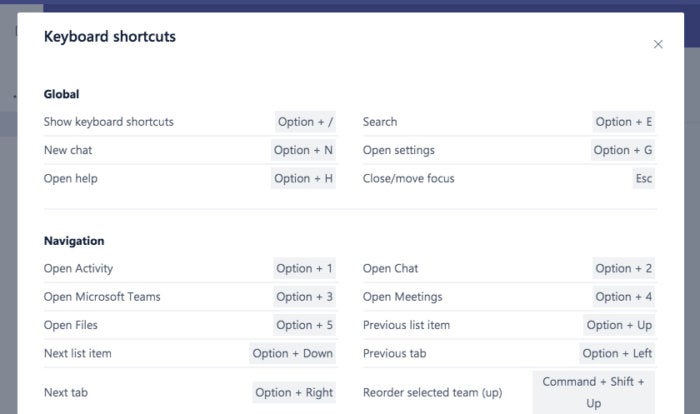 Microsoft
MicrosoftWhile some employees are eager to try new tools such as Microsoft Teams, many are more often content to stick to familiar apps and may need more encouragement to embrace a new way of working.
“If you have been using Outlook as the center of your world for the best part of 10, 15 or 20 years, then moving to anything else is always going to present a challenge, unless you can see unequivocally that it is a better environment to get work done,” Edwards said.
Willis said that while messaging apps can be simple to use, training is often required to get the most from a tool such as Teams. “Developing governance and security strategies and processes, then putting the organization’s weight behind proper training, are steps that many organizations overlook,” said Willis.
This can lead to situations “where their employees either aren’t utilizing the new software,” or the exact opposite – utilization spins out of control “before anyone can steer organizational processes toward even a modest amount of structure.”
Microsoft Teams replaces Skype for Business: What it means to you
One of the most significant developments around Teams was Microsoft’s decision to replace Skype for Business with Teams.
The idea is to create a “single hub for teamwork,” with Skype for Business being phased out. (There will still be a new version of Skype for Business Server software next year.)
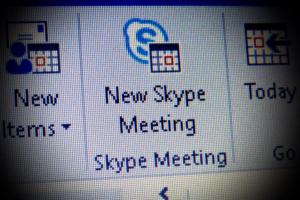 Peter Sayer/IDG
Peter Sayer/IDG“We quickly moved from Teams as the chat-based workspace to the hub for teamwork,” said Lori Wright, general manager for Microsoft Teams, “and what we saw was that collaboration and communications are inextricably linked: you can’t have true collaboration if you don’t have the ability to communicate, to have unified communications, to make a phone call, to have a voice or video meeting. All of these things are core to the collaboration experience.”
Gartner’s Cannell said the transition from Skype for Business to Teams should be relatively smooth. “For most companies that are using Skype for Business just for instant messaging and for their online meetings, Teams is going to be a pretty good option for them,” he said.
But customers that have gone “all-in” with Skype for Business and replaced desktop telephones with the voice capabilities in the app may face more hurdles. “Those are the cases that are going to have a little bit more difficulty. But if it is for the most basic instant messaging, online meetings, audio conferencing, video conferencing, screen sharing and so forth, Teams does a pretty good job with that,” Cannell said.
Avepoint’s Willis argued that Teams is “already more powerful on its own than Skype for Business.”
He suggests that once IT teams have properly tested Teams, strategies and training plans should be put in place to aid migration. Change management strategies are required, such as “creating pilot groups, finding enthusiastic adopters and power users to evangelize the transition and setting up self-service training resources…. [Those] are great places to start with this process.”
As with anything, he said, the sooner organizations prepare and the more they plan, the smoother the transition will go.
Microsoft Teams’ road map
Microsoft offered a glimpse of the features coming to Teams at its Enterprise Connect conference in Orlando in March. They include:
- Cloud recording and transcriptions of audio.
- Cortana interactions for Teams-enabled devices, such as conference room speaker phones.
- In line message translation in Teams chat.
- Background blur for individuals on Teams video calls.
There are also planned enhancements to enterprise call capabilities, such as call delegation and federation, direct routing and consultative transfer.
To some degree, Teams is still a work in progress, said Edwards. In its current form, it could be considered “Teams 2.0,” he said. “That signals you should come and have a proper look at Microsoft Teams with an open mind.” He expects upcoming features will appeal to a wide range of users.
Although Teams is a relatively new technology, Microsoft’s investment in Teams is a sign of the strength of the collaboration market more generally, Cannell said.
“Will this be the final collaborative solution that really gets adopted broadly and will Teams surpass the use of Outlook? I think we are going too far there, but the fact that Microsoft has embraced this type of group messaging is good for the industry.
“So I’m cautiously optimistic about the future of enterprise collaboration now that Microsoft is pushing in the direction of Teams.”
source:-.computerworld


